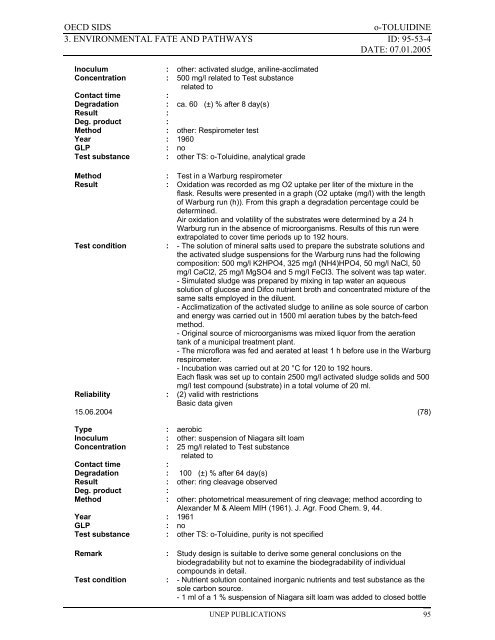o-TOLUIDINE CAS N°: 95-53-4 - UNEP Chemicals
o-TOLUIDINE CAS N°: 95-53-4 - UNEP Chemicals
o-TOLUIDINE CAS N°: 95-53-4 - UNEP Chemicals
You also want an ePaper? Increase the reach of your titles
YUMPU automatically turns print PDFs into web optimized ePapers that Google loves.
OECD SIDS o-<strong>TOLUIDINE</strong><br />
3. ENVIRONMENTAL FATE AND PATHWAYS ID: <strong>95</strong>-<strong>53</strong>-4<br />
DATE: 07.01.2005<br />
Inoculum : other: activated sludge, aniline-acclimated<br />
Concentration : 500 mg/l related to Test substance<br />
related to<br />
Contact time :<br />
Degradation : ca. 60 (±) % after 8 day(s)<br />
Result :<br />
Deg. product :<br />
Method : other: Respirometer test<br />
Year : 1960<br />
GLP : no<br />
Test substance : other TS: o-Toluidine, analytical grade<br />
Method : Test in a Warburg respirometer<br />
Result : Oxidation was recorded as mg O2 uptake per liter of the mixture in the<br />
flask. Results were presented in a graph (O2 uptake (mg/l) with the length<br />
of Warburg run (h)). From this graph a degradation percentage could be<br />
determined.<br />
Air oxidation and volatility of the substrates were determined by a 24 h<br />
Warburg run in the absence of microorganisms. Results of this run were<br />
extrapolated to cover time periods up to 192 hours.<br />
Test condition : - The solution of mineral salts used to prepare the substrate solutions and<br />
the activated sludge suspensions for the Warburg runs had the following<br />
composition: 500 mg/l K2HPO4, 325 mg/l (NH4)HPO4, 50 mg/l NaCl, 50<br />
mg/l CaCl2, 25 mg/l MgSO4 and 5 mg/l FeCl3. The solvent was tap water.<br />
- Simulated sludge was prepared by mixing in tap water an aqueous<br />
solution of glucose and Difco nutrient broth and concentrated mixture of the<br />
same salts employed in the diluent.<br />
- Acclimatization of the activated sludge to aniline as sole source of carbon<br />
and energy was carried out in 1500 ml aeration tubes by the batch-feed<br />
method.<br />
- Original source of microorganisms was mixed liquor from the aeration<br />
tank of a municipal treatment plant.<br />
- The microflora was fed and aerated at least 1 h before use in the Warburg<br />
respirometer.<br />
- Incubation was carried out at 20 °C for 120 to 192 hours.<br />
Each flask was set up to contain 2500 mg/l activated sludge solids and 500<br />
mg/l test compound (substrate) in a total volume of 20 ml.<br />
Reliability : (2) valid with restrictions<br />
Basic data given<br />
15.06.2004 (78)<br />
Type : aerobic<br />
Inoculum : other: suspension of Niagara silt loam<br />
Concentration : 25 mg/l related to Test substance<br />
related to<br />
Contact time :<br />
Degradation : 100 (±) % after 64 day(s)<br />
Result : other: ring cleavage observed<br />
Deg. product :<br />
Method : other: photometrical measurement of ring cleavage; method according to<br />
Alexander M & Aleem MIH (1961). J. Agr. Food Chem. 9, 44.<br />
Year : 1961<br />
GLP : no<br />
Test substance : other TS: o-Toluidine, purity is not specified<br />
Remark : Study design is suitable to derive some general conclusions on the<br />
biodegradability but not to examine the biodegradability of individual<br />
compounds in detail.<br />
Test condition : - Nutrient solution contained inorganic nutrients and test substance as the<br />
sole carbon source.<br />
- 1 ml of a 1 % suspension of Niagara silt loam was added to closed bottle<br />
<strong>UNEP</strong> PUBLICATIONS <strong>95</strong>
















